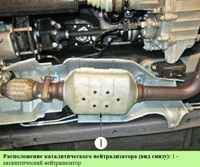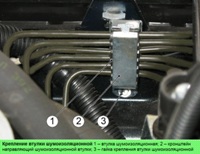The control oxygen concentration sensor (lamda probe) is installed in the exhaust pipe of the exhaust system.
The controller calculates the duration of the fuel injection pulse from parameters such as mass air flow, engine speed, coolant temperature, throttle position.
According to the signal from the sensor about the presence of oxygen in the exhaust gases, the controller adjusts the fuel supply by the injectors so that the composition of the exhaust gases is optimal for the efficient operation of the catalytic converter.
The controller constantly outputs a stabilized reference voltage of 450 mV to the sensor circuit.
The oxygen contained in the exhaust gases creates a potential difference at the output of the sensor, varying from approximately 50 to 900 mV.
A low signal level corresponds to a lean mixture (the presence of oxygen), and a high level of a rich mixture (no oxygen).
When the oxygen concentration sensor is in a cold state, there is no output signal from the sensor, because its internal resistance in this state is very high, several MΩ.
In this case, the controller controls the injection system without taking into account the voltage on the sensor, the engine control system operates in an open loop.
For normal operation, the oxygen concentration sensor must have a temperature of at least 360 ° C, therefore, for quick warming up after starting the engine, a heating element controlled by the controller is built into it.
As the sensor warms up, the resistance drops and it begins to generate an output signal.
Then the controller turns off the sensor heating and starts taking into account the oxygen concentration sensor signal for fuel control in closed loop mode.
The oxygen sensor can be poisoned by the use of leaded gasoline or the use of sealants containing large amounts of silicone (highly volatile silicon compounds) when assembling the engine.
Silicone fumes can enter the combustion chamber through the crankcase ventilation system.
The presence of lead or silicon compounds in the exhaust gases can lead to sensor failure.
In the event of a failure of the oxygen concentration sensor, the controller turns on the control system malfunction indicator and controls the fuel supply in an open loop.
A diagnostic oxygen sensor is installed in the exhaust system after the catalytic converter.
The device and principle of operation of the diagnostic sensor are the same as those of the control oxygen concentration sensor.
The signal generated by the sensor indicates the presence of oxygen in the exhaust gases after the converter.
If the converter is working properly, the readings of the diagnostic sensor will differ significantly from the readings of the control sensor.
The voltage of the output signal of the heated sensor when operating in closed loop mode and a working neutralizer should be in the range from 590 to 750 mV.
If the diagnostic oxygen concentration sensor or its circuits fail, the controller stores a fault code in its memory and turns on the fault indicator in the instrument cluster.
Replacing oxygen sensors
Oxygen sensors need to be replaced every 75,000 km of the vehicle.
Unscrew the sensors when the engine is cold.
Disconnect the negative battery terminal.
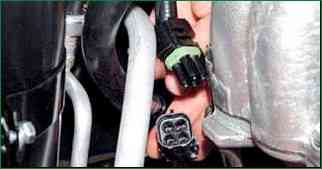
To replace the control sensor, in the engine compartment, press the lock of the wire block and disconnect it
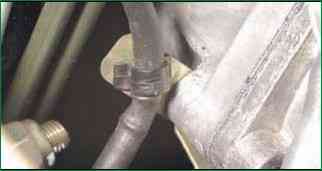
Disconnect the plastic holder of the sensor wiring harness from the bracket

Use the 22 key to turn off the sensor
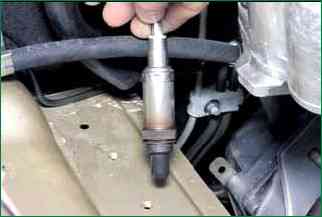
Remove the sensor from the engine compartment
If the sensor is very stuck and it is impossible to unscrew it with an open-end wrench, then if you are replacing the sensor, you canbite the sensor wires with side cutters and unscrew it with a spanner wrench.
You can still disassemble the wiring block if the sensor cannot be replaced.

To replace the diagnostic oxygen sensor, we pry off the bottom of the car with a screwdriver and disconnect the wire holder from the protective cover of the wire blocks.
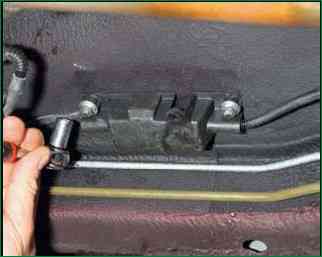
Use a 10 key to unscrew two nuts.
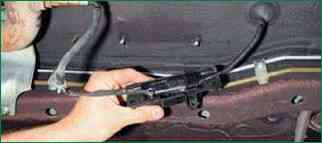
Remove the protective cover with wire blocks

Remove the wire blocks from the protective cover
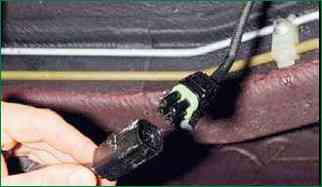
We press the lock of the pad, disconnect the pads of the wiring harnesses

Use the 22 key to turn off the sensor
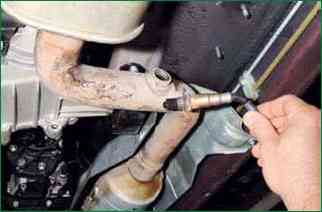
Remove the diagnostic sensor
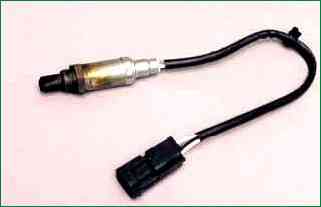
When installing the sensor, do not allow dirt and grease to get on the pads and on the sensor itself.
Install the sensors in reverse order.







